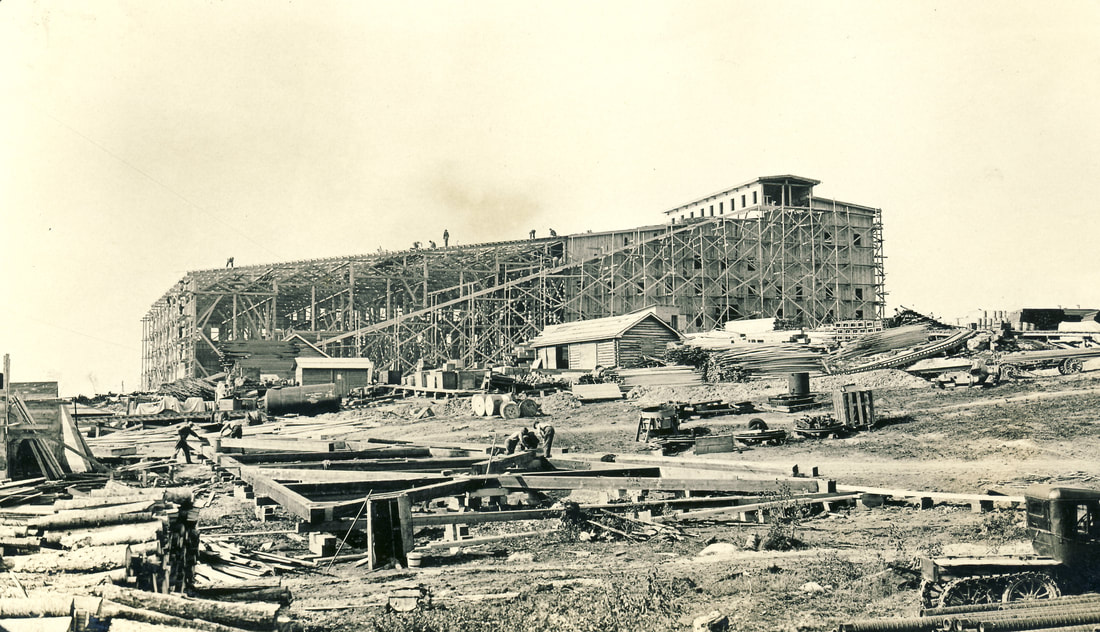Mining in Red Lake
Mining
Geologically the Red Lake area is a part of the Canadian Shield. Worn and exposed by hundreds of thousand years of erosion, the Shield provided prospectors with a glimmer of hope about the mining potential in the region. The original prospectors were seeking silver. After the 1924 release of a Canadian geological survey of the upper English River Valley, the GOLD RUSH was on. By New Year's Day 1926, news of the gold finds had finally reached the outside world. The ensuing gold rush brought prospectors from all over to the area, including sourdoughs from the Yukon's Klondike Gold Rush.
The Town of Hudson became the staging area of this gold rush. More than 3,000 men drove dog teams and rode on sleighs up the frozen Hudson River in search of their fortune. Six days and nights of blistering cold had to be endured before the prospectors arrived at the Red Lake base camp. The Red Lake gold rush spawned a number of unique northern transportation companies during this period, especially the float planes that would come to dominate the industry within 20 years. In the early days, however, companies like the Red Lake Transport Company with their sixty teams of horses for winter freighting and stern wheel barges, tugs and freighter canoes for the summer months, and the more expensive motor launches of the Lac Seul Trading Company, provided a number of alternatives for the prospectors to get to their claims. Most importantly though fast transportation was needed to get their finds to the southern markets.
By the end of 1926, Red Lake was a thriving service centre for area prospectors and construction workers, many of whom were sinking a shaft and building milling facilities at the Howey Gold Mine - the area's first major mining development. The Howey Gold Mine began mining and milling gold in 1930 and used hydroelectric power from a hydro generation plant built in Ear Falls between 1928 and 1930.
Many other mines were in the process of opening at that time. McKenzie Red Lake went into production five years after the Howey. The many others that followed include Red Lake Goldshore, Gold Eagle, Madsen Red Lake, Hasaga, Cochenour-Willans, McMarmac, Starratt- Olsen, Dickenson, Placer Dome (Campbell Mine), H.G. Young, Buffalo, Albino, and Lake Rowan. Of these mines, Campbell and Dickenson Mines now owned by Evolution Mining Ltd. is still in production. Over 28M oz. of gold has been mined in the area.
Gold is not the only mineral mined in the area. In 1953 an iron ore deposit was found at Bruce Lake. The Griffith Mine site produced high-grade ore for twenty years. The southern boundary of the district has world-famous granite deposits. Also known as Vermilion Pink, 20-30 ton blocks are shipped to carvers and fine stonemasons all over the world. The growth of the forest industry in the district coincided with development in the gold rush period. The forest industry today represents both logging and manufacturing of pulp and paper, and value-added forestry products such as oriented strand board (OSB). Mechanization of the industry including the use of satellite imaging is making companies more efficient while simultaneously working to protect sensitive ecological sites.
From 1925 to the present there have been more than 28 different mine sites developed and mined in the area. New areas continue to be explored. Gold continues to be the major industry in the Red Lake District.
Evolution Mining Ltd. Red Lake Mine
Formerly the Campbell Mine located in Balmertown has been in continuous operation since 1949 producing more than 10 million ounces of gold. The mine currently employs some ~900 employees & contractors.
Formerly the Dickenson Mine (re-opened by Goldcorp), Evolution's Red Lake Mine has proven and probable gold reserves above 9 million ounces. Evolution has planned operational changes including:” improved drill & blast practices to increase mining recovery & reduce dilution, improve mining fleet efficiency and effectiveness and rationalization of material movement.”
The spectacular high-grade ore body has renewed interest in the Red Lake goldfield by both major and junior mining companies. The mine also has interests in other properties in the Red Lake area with mine potential.





